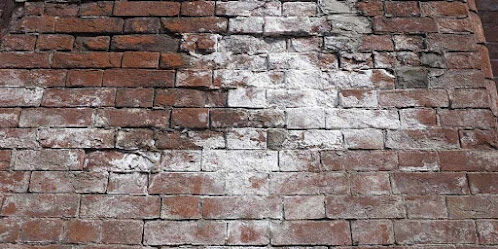The
Word ‘Efflorescence’ is used to describe the depositing of
soluble salts (in other words, those that dissolve in water) on the surface of
finished brickwork. Salts of magnesium, calcium, potassium or sodium may have
been present in the clay used to make the bricks or in the sand used to make
the mortar.
What are the Sources of Soluble Salts?
The sources of soluble
salts Common efflorescence derives mainly from soluble salts that are contained
in clay bricks and sands used for mortars but sometimes in other sources,
including ground water.
Clay
Impurities in clay raw
material from which bricks are made, include various soluble salts. These salts
are impossible to remove before bricks are made, and can cause problems of
efflorescence and sulphate attack on cement mortar in walls which may be wet
for long periods each year in completed buildings.
Mortar sands
Most sands come from
pits or river beds, and contain few salts. Sea sands contain many harmful
salts, however, and should not be used for mortars unless they have been
effectively washed by a reliable supplier.
Cement
Portland cement is the
main binder constituent used, and its contribution to efflorescence is minimal.
Mainly due to the desire to reduce carbon emission from cement production,
alternative binders are used in modern cements and they can contain appreciable
quantities of sodium sulfate, which is a common cause of efflorescence
Detergents used as plasticisers
Many detergents
contain sodium sulfates and should under no circumstances be used in place of
properly formulated proprietary mortar plasticisers (see Section 3.1).
Other sources
Bricks may absorb
salts from ashes or the soil on which they are standing or from materials
stacked or heaped in contact with them.
How efflorescence in brickwork forms?
Water dissolves
soluble salts in the bricks or mortar and holds them in solution.
As the water
evaporates and the wall dries out, the solution becomes more concentrated until
salts begin to be deposited.
This may occur out of
sight within the pores of the brick or on the surface.
Exactly where, when
and how much efflorescence will occur is difficult to predict. Because it
dependent on complex chemical and physical conditions such as the type of
salts, the pore structure within the brick, the rate of drying by wind and sun,
and the degree of saturation of the brickwork. The latter is the only condition
which we can readily control.
How to minimize the risk of efflorescence in brickwork?
The risk cannot be
entirely avoided, as it is not practicable to eliminate all salts from bricks
and mortars, or to keep them virtually dry, but it can be minimised by reducing
the amount of water penetrating the brickwork.
Design details
Designers can use
‘umbrella’ details which protect the brickwork from saturation. Such details
include effective roof verges and eaves, copings and sills to shed run-off
water clear of the brickwork below.
They should also avoid
details which shed water onto projecting plinths and other features.
Site practice
·
Bricklayers and site
supervisors are responsible for good site practice.
·
Bricks should be
stacked clear of the ground on pallets, or by other means.
·
Mortar materials
should be kept free from contamination.
·
Bricks in stacks or on
the scaffolding, and newly built brickwork, should be protected from
saturation, particularly during the seven days after bricklaying.
·
Scaffold boards
adjacent to the brickwork should be turned back during rain to avoid splashing
causing a band of efflorescence as well as mortar stains.
Choice of bricks
New bricks are tested
by manufacturers for the extent to which they are likely to effloresce and
bricks are graded on the following scales in terms of the bricks’ exposed
surface area:
·
Nil
: no perceptible
efflorescence.
·
Slight
: no more than 10
per cent displays a thin covering.
·
Moderate
: thin covering
affecting between 10 and 50 per cent.
·
Heavy
: heavy deposits
affecting more than 50 per cent but with no flaking.
·
Serious
: heavy deposits
displaying surface powdering/ flaking, which increases during wet weather.
Before finalizing
sources of brick for procurement, always do sampling of brick and
test it for efflorescence as per IS code. If it passes the test, then go for
procurement.
Efflorescence can be
avoided, or at least minimised, by appropriate design detail and good site
practices.
How to Treatment Surface Affected by Efflorescence?
The only real solution
to efflorescence is periodically to brush off the salt deposits from dry
brickwork as they come to the surface until, over time, all the salts have been
released.
Always use a bristle
brush and never a wire brush.
It is a mistake to try
to wash off the efflorescence as this will merely re-dissolve the salts and
wash them back into the brickwork, ready to emerge again when the brickwork
dries out.
Do not use acid
treatment, as apart from the danger to people and materials by inexpert use,
some salts such as vanadium (a trace metallic compound associated mainly with
fireclays) may be fixed permanently.
Internal efflorescence
may be treated by dissolving small patches with very little water, say a fine
mist spray. The surface may then be dried with a damp sponge but, because some
users have reported that this sometimes causes a blotchy appearance, it is
advisable to experiment on a small inconspicuous surface at first. The
absorbent material must be constantly renewed or washed free of salts.


No comments:
Post a Comment